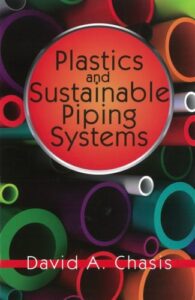Plastics and Sustainable Piping Systems
Plastics and Sustainable Piping Systems
Plastics and Sustainable Piping Systems contains 46 articles divided into three sections. The first section, General Plastics, comprises articles that address the present, past, and future of plastics in general. Many of the articles explain, defend, and also promote the use of plastics in the world, offering several examples of why plastics should be the environmentalist’s best friend.
Plastic is defined as a synthetic material made from a wide range of organic polymers that can be molded into shape while soft, and then set into a rigid or slightly elastic form (definition adapted from Oxford English dictionary). These man-made materials have grown astronomically over the last 100 years, offering many features and benefits throughout such industries as clothing, appliances, transportation, packaging, chemical processing, electronics, and medical.But no industry has benefited more from the advent of plastics than that of construction, building with such products as wall and floor coverings, window frames, siding, roofing, decking, fences, and piping systems. This book focuses mainly on plastic piping systems.
You can also Read Gas Turbine Handbook Principles and Practice, 5th Edition
Plastics and Sustainable Piping Systems Content
- Table of Contents by Topic
![Plastics and Sustainable Piping Systems Plastics and Sustainable Piping Systems]()
- Acknowledgements
- Preface
- General Plastics
- General Plastic Piping
- Plastic Piping Material
- Plastic Piping Products
- Sustainability
- History
- Information Sources
- Environmental Issues
The second section, General Plastic Piping, concentrates on plastic piping areas such as applications, joining methods, and the environment. Almost all the piping materials listed are thermoplastic (plastics that can be easily recycled and transformed by applying heat and then cooled with the end product having the same physical properties of the original material). (There is no coverage in the book of thermo set piping materials such as fiberglass reinforced polymers. Thermosets are plastics that, once formed, cannot be recycled back into its original form.)


Thanks